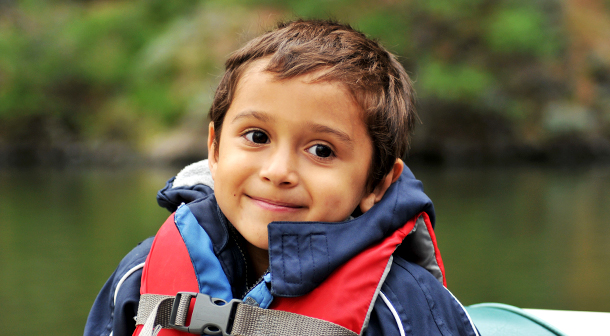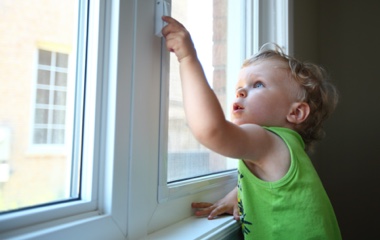Water Safety Tips for Parents
Water is a great source of family fun, from swimming, fishing, canoeing, boating, and skiing to even just floating in a tube. If your family is spending time in or even near water, it's important for everyone to practice water safety. One of the best things you can do to is to learn and follow the recommended water safety tips below.
In the U.S., children ages 1 to 4 have the highest drowning rates. In fact, 87 children drowned in Texas in 2019 and more than half were age 4 or younger, according to the Texas Department of Family and Protective Services. By taking part in water safety activities and knowing how to spot dangers before they happen, you can help keep everyone safe around water.
Drowning is silent and fast - it can happen very quickly, even with lots of people around.
Water Safety Tip #1: Always Choose a Water Watcher
Water safety for kids starts with always having a responsible adult designated as the Water Watcher anytime small children are swimming or near water, even when lifeguards are present. You can decide whether you need more than one Water Watcher based on how many children are present.
Being a Water Watcher is a very serious job, and the watcher should follow these water safety tips:
- Stay focused. There's no room for multi-tasking. The Water Watcher should not be distracted by a book, phone, or other adults.
- Make sure the watcher is an adult. Older children should never have the responsibility of being the Water Watcher.
- Pay special attention to new swimmers. If there are new swimmers or non-swimmers, the Water Watcher should be within arm's reach of them.
- Get water safety training. If possible, choose a Water Watcher who has water safety training and knows CPR.
- Check the water first. If a child is missing, look in the water first.
- Have a phone nearby. While the Water Watcher shouldn't be on their phone, keep a phone nearby in case of emergencies.
- Never leave the post. The Water Watcher must stay at their post until they are replaced by another watcher.
Need parenting help now?
The Texas Parent Helpline is available 24/7.
- Call 833-680-0611
- Chat with us
- Text 833-680-0611
Water Safety Tip #2: Don't Rely on Water Toys
Never use water toys to protect weak swimmers - this includes water wings, noodles, floaties, or inner tubes. Air-filled or foam toys are not safety devices and are not designed to keep swimmers safe. U.S. Coast Guard-approved life jackets are the only water safety devices that are certified to protect children.
If you're on a boat or a dock or near a body of water, children should wear life jackets. The law says all children under 12 must wear a life jacket while boating, and for good reason - studies show that potentially half of all boating deaths might have been prevented with the use of life jackets. Also, life jackets only work well when they are worn correctly.
- Make sure the life jacket is the right size.
- Follow the manufacturer's instructions - all straps should be fastened, and the life jacket should not be loose.
- Anytime you are on a boat, adults should set a good example and wear a life jacket, too.

Water Safety Tip #3: Get Swimming Lessons
One of the best water safety activities you can do to protect your kids is to take water safety training - swimming lessons! Research has shown that formal swimming lessons can reduce the risk of drowning among children ages 1 to 4 years. It doesn't have to be expensive - you can look at your local community center or YMCA to find free or low-cost swim lessons in your area.
Look for programs with qualified instructors who teach essential skills and water safety training. Depending on your child's age and abilities, you may want to start with mommy-and-me or daddy-and-me classes that have parents participate with their kids. Designed for children under age 4, these parent + toddler classes are usually designed to build swim readiness. By the time your child is 4 years old, swim lessons or water safety training is a must. Once your child has had swim lessons, don't let your guard down - even when children have had formal swimming lessons, adult supervision is still an essential part of water safety for kids.
Water Safety Tip #4: Be Safe at the Public Pool
Public pools are a great way to beat the summer heat - but don't let a lifeguard on duty lull you into thinking that you don't have to stay vigilant. When your family is at a public pool, it's still important to stay alert and choose an adult to be the Water Watcher. Even if you've talked with your children about water safety for kids, don't assume they'll use good judgment and caution around the pool - because kids will be kids. As they get older, kids may prefer to be dropped off at the pool, but it's always best to have an adult Water Watcher present.
Watch Out for Pool Drains
Teach children to avoid drains in the pool. Pool drains use suction to filter the water, and children have been trapped under water by drains. Government rules now require all pools to have safety drain covers to prevent accidental drownings, but you can't be sure they are always in place, so a great kid water safety tip is to stay away from the drains.
Water Safety Tip #5: Be Safe Around Open Water
Texas is full of beautiful creeks, ponds, lakes, rivers, and beaches that offer lots of opportunities to make fun family memories. Before you go to an outdoor water area, be sure to talk with your children about water safety. Make sure kids know how important it is to follow all the rules and to never swim or play in water alone and always go with a buddy. Once you arrive at your recreation area, make sure you appoint an adult to be the Water Watcher.

Open Water Do's and Don'ts
Pay attention to signs and swimming area boundaries, and make sure you follow the specific water safety rules of the area that you're visiting.
Do's - Tell your child to:
- Always swim with a buddy-that goes for adults, too.
- Stay within the designated swim area.
- Watch for swim condition flags or signs.
- Enter the water feet first every time.
- Always wear a life jacket when on a boat or swimming in open water.
- Be aware of currents. If they're caught in a current, swim parallel to the shore until they can get free.
Don'ts:
- Don't let kids of any age roughhouse or race each other across water.
- Don't let kids swim around boats or other watercraft.
- Don't let kids swim in murky water or near drop-offs.
- Tell your child to never dive off swim platforms or into murky water.
- Tell your child to not play or swim in ponds, streams, gullies, ditches, canals, etc.
Never dive into water without knowing how deep the water is.
Water Safety Tip #6: Be Safe at the Waterpark
There is no consistent federal regulation of waterparks, so before you go, you'll want to do your own research to make sure the park is safe.
Waterpark water safety tips
If you plan to take children to a waterpark, make sure you know their swimming abilities so they don't end up on a ride or attraction that could be dangerous for them. Know the rules of the park and understand each ride or attraction before you allow a child to participate.

Do's:
- Make sure everyone - even a grown-up - has a buddy.
- Get life jackets for small children and weak swimmers. Many parks have them available to rent or borrow.
- Supervise children at all times, even when lifeguards are present.
- Have an adult stay within arm's reach of small children and weak swimmers.
- Watch children extra closely in wave pools, where it can be hard to spot a swimmer in trouble.
Don'ts:
- Don't let you children drink the water, even if it's chlorinated. It can still contain bacteria.
- Don't let anyone pressure a child to go on a ride that seems out of their comfort zone. Remember, it's supposed to be fun.
Water slides are the number one cause of injuries at waterparks, but wave pools carry the biggest risk of drowning.
Water Safety Tip #7: Other Ways to Stay Safe
Drowning isn't the only health and safety concern when you're visiting a pool or other water area. Here are a few other water safety tips parents should follow anytime children are swimming:
- To avoid slips and falls, teach kids not to run around the pool area.
- Many germs are killed by the pool chemicals, but kids should know not to drink pool water.
- Teach kids not to pee or poop in the pool. Check swim diapers frequently and take kids on bathroom breaks at least every hour.
- Be sure no child who is having diarrhea gets in the water.
- After swimming, teach kids to tilt their heads back and forth several times to help water drain from their ear canals, and dry their ears with a towel. This can help prevent swimmer's ear and ear infections.
- Take extra snacks to prevent meltdowns - kids burn more energy when they're swimming and playing in the sun.
- Take plenty of water to make sure everyone stays hydrated.
- Wear sunscreen, and re-apply frequently, even if it's a cloudy day.
- Pick a meeting spot in case you get separated.
The Red Cross offers Water Safety Training.





